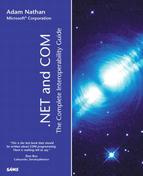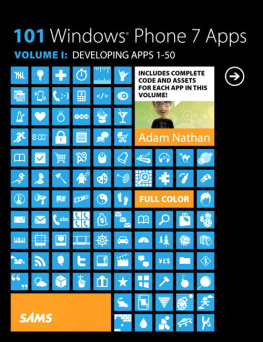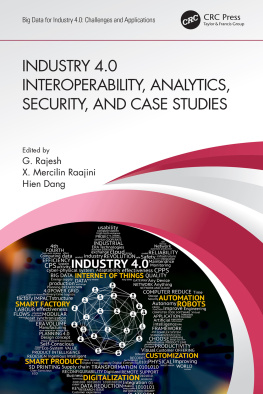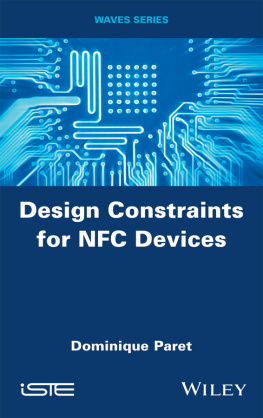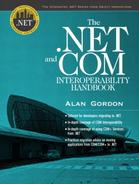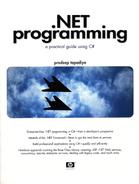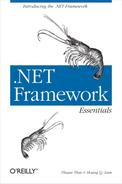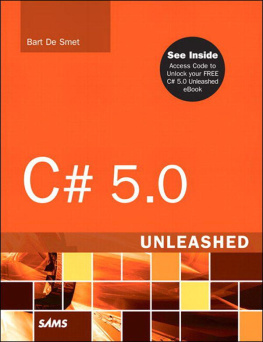.NET and COM: The Complete Interoperability Guide
Adam Nathan

800 East 96th St., Indianapolis, Indiana, 46240 USA
.NET and COM: The Complete Interoperability Guide
Copyright 2002 by Sams Publishing
All rights reserved. No part of this book shall be reproduced, stored in a retrieval system, or transmitted by any means, electronic, mechanical, photocopying, recording, or otherwise, without written permission from the publisher. No patent liability is assumed with respect to the use of the information contained herein. Although every precaution has been taken in the preparation of this book, the publisher and author assume no responsibility for errors or omissions. Nor is any liability assumed for damages resulting from the use of the information contained herein.
International Standard Book Number: 0-672-32170-x
Library of Congress Catalog Card Number: 2001093566
Printed in the United States of America
First Printing: January 2002
Third Printing with corrections: April 2004
06 05 02 04 6 5 4 3
Trademarks
All terms mentioned in this book that are known to be trademarks or service marks have been appropriately capitalized. Sams Publishing cannot attest to the accuracy of this information. Use of a term in this book should not be regarded as affecting the validity of any trademark or service mark.
Warning and Disclaimer
Every effort has been made to make this book as complete and as accurate as possible, but no warranty or fitness is implied. The information provided is on an as is basis. The author and the publisher shall have neither liability nor responsibility to any person or entity with respect to any loss or damages arising from the information contained in this book.
EXECUTIVE EDITOR
Shelley Kronzek
DEVELOPMENT EDITOR
Anne Marie Walker
MANAGING EDITOR
Matt Purcell
PROJECT EDITOR
Andy Beaster
COPY EDITORS
Ned Snell
Katie Robinson
INDEXER
Ginny Bess
PROOFREADERS
Kay Hoskin
Plan-It Publishing
TECHNICAL EDITORS
Dave Mortenson
Bob Willer
TEAM COORDINATOR
Pamalee Nelson
INTERIOR DESIGNER
Anne Jones
COVER DESIGNER
Aren Howell
PAGE LAYOUT
Susan Geiselman
Rebecca Harmon
Cheryl Lynch
Michelle Mitchell
Dedication
To my high school sweetheart, best friend, and beautiful bride, Lindsay.
Contents at a Glance
Foreword
Working on the Common Language Runtime (CLR) for the past three-and-a-half years has been a fantastic opportunity. Its not often that you get the chance to work on a project where you can forget about the past and design an exciting new set of technologies from the ground up, uninhibited by the constraints of maintaining backward compatibility.
The CLR offers a fresh solution to the problems developers face in building and using reusable components and deployable applications. Its an entirely new architecture aimed squarely at simplifying the development and deployment process. In designing the CLR we took the opportunity to step back and look at the process of writing reusable components using COM today. We examined the problems people had with things like reference counting, apartments, and registration, and we looked at the aspects of the model that made building COM components complicated. One of the primary design goals in building the CLR was to eliminate that complexity. In short, it was time to make programming fun again.
COM was nothing short of revolutionary when it was first introduced. It provided a standard mechanism with which developers could build reusable components. Most developers like to forget about the pre-COM days, when linking to static DLL exports was about as close as you could get to reusability. Over the years, the popularity of COM has grown enormously, to the point where today, just about every application that provides any level of extensibility does so using COM. But as features were added, the complexity of COM has grown. After nearly ten years of COM enhancements, that complexity reached the point where it began to seriously impede developer productivity.
In some ways, COM is like your 1994 Ferrari. When you first sat in the drivers seat, you thought it was the greatest, but after a few years, the novelty wore off, and all you focus on is that rattle under the hood and the grinding in the transmission when you try to shift into third gear. After programming with COM for several years, joining the CLR team was like an opportunity to build a new Ferrari, with cool new features that promised to make driving fun again. We had the talent, we had the resources, and we had a 1994 Ferrari sitting in the garage for reference. Most importantly, we had management-level support to build the best darn Ferrari we possibly could. There was only one catchnot everyone could afford a new Ferrari, and even those who could were sometimes a bit skeptical of all the new features. After all, most of the older models were still working pretty well, as long as you stayed out from under the hood.
Surprisingly, some people were actually interested in buying parts of the new Ferrari to use in older models rather than buying a whole new car. And believe it or not, some people loved the old-style Ferrari so much they even wanted to put old parts on the new cars. It seemed that no matter how cool the new model was, there was always someone asking, Will I be able to take that transmission and put it in my 94 Ferrari? Here we were designing this fabulous new machine, and all people could think about was backward compatibility. (Well, that may not be exactly how it went, but its not far off.)
Faced with these requests for compatibility, we formed the Interoperability team within the CLR, whose role it was to build a bi-directional bridge between COM and .NET. Wherever possible, we ignored compatibility constraints in designing the features of the CLR so that we could use the best possible design. Once the feature was designed, the Interop team was faced with the task of bridging the features between .NET and COM. In most cases, the Interop team was able to build the bridge without affecting the initial design. In rare cases (such as enumerations), the interoperability constraints forced us to change the original design for better backward compatibility.
Designing, building and testing this Interop bridge was no small task. It required talented people who had both COM and .NET expertise. Of those involved, Adam Nathan, author of this book, was one of the most talented and important players. Adam joined the team early in the process as a member of the Interop test team. If you had access to the RAID database we use to track bugs, youd find that Adam has filed a whopping 2022 bugs since the project started (and hes not done yet). Thats more bugs than anyone else on the entire team. These werent trivial bugs, and an amazing 1873 of them were resolved fixed. Getting a bug fixed is the equivalent of a base hit for a tester; if Adam played for the Seattle Mariners, hed be batting .926 (thats even better than Ichiro). Equally impressive is how few bugs Adam opened that were resolved by designonly 44 bugs, or two percent of the total. From a program managers perspective, Adam is the kind of test developer you wish you could have on your team.

